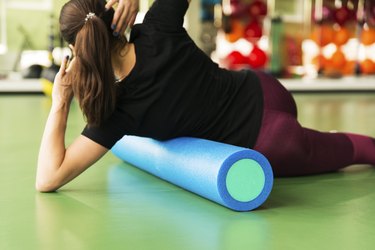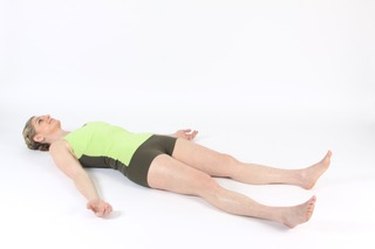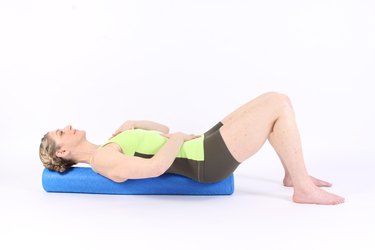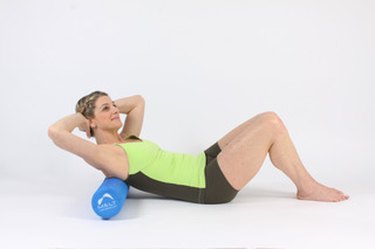
When you're in pain, you may not always feel like going (or be able to go) to your doctor, physical therapist or chiropractor for help.
The MELT Method promises natural pain relief at home, without using medication. Sue Hitzmann, a fitness professional and hands-on bodyworker, created the MELT Method, an acronym for myofascial energetic length technique, to allow people to become their own bodyworkers and eliminate their own pain.
Video of the Day
But can the MELT Method really make nagging aches vanish? And who should try it? Here's what you should know.
What Is the MELT Method?
The MELT Method "blends mindful meditation, breathwork and restorative self-myofascial release (SMR) techniques to help boost natural healing mechanisms," says Hitzmann, who published her New York Times-bestseller on the practice, The MELT Method: A Breakthrough Self-Treatment System to Eliminate Chronic Pain, Erase the Signs of Aging, and Feel Fantastic in Just 10 Minutes a Day, in 2013.
You're probably familiar with meditation and breathing exercises, but "self-myofascial release techniques" might be a new term, so let's unpack it.
Myofascial Release
Myofascial release (or MFR) is a type of gentle, hands-on therapy that involves stretching and massage (and more) to treat the body's myofascial system, which includes the muscles and surrounding connective tissue, called fascia, according to the Cleveland Clinic.
The goal is to ease pressure in the fascia, the idea being that less pressure can help correct alignment issues caused by stress, injury, illness or poor posture, according to the National University of Health Services.
To work properly and keep you pain-free, fascia needs to be lubricated with hyaluronic acid, a substance our bodies produce naturally. Hyaluronic acid allows fascia to glide smoothly over muscles and tendons, according to a June 2013 review in Current Pain and Headache Reports.
One theory laid out in that report is that when the hyaluronic acid becomes sticky, instead of lubricated, it might cause stretching in the fascia that could lead to pain. It's thought that massage and other hands-on therapies might help lubricate the hyaluronic acid (and thus, the fascia), according to the Current Pain and Headache Reports findings.
This, in turn, is the basis of MFR, although more research is needed to truly understand the way manipulation may affect the fascia.
Self-Myofascial Release
Self-MFR or SMR, as the name implies, is myofascial release you can do yourself.
In recent years, fitness professionals began teaching patients how to use MFR therapy on their own to manage their pain, primarily through foam rolling, according to an April 2017 report in the Journal of Bodywork and Movement Therapies.
The MELT Protocol
The MELT Method combines SMR, breathwork and meditation using what's called a "4R protocol". The four Rs stand for:
- Reconnect
- Rebalance
- Rehydrate
- Release
Reconnect
The Reconnect techniques are about becoming more in tune with your body and determining which areas need your attention.
The position above is called "rest assess," where you lie on the floor with your arms and legs relaxed, palms facing up. The MELT Method prescribes closing your eyes and using your "body sense," Hitzmann says, to determine if you feel any or all of these common imbalances:
- Is all your upper-back weight on your shoulder blades?
- Is your entire mid-back arched off the floor?
- Is more weight in your tailbone than your butt cheeks?
- Are the backs of your thighs off the floor on one or both sides?
If you notice any of these issues, you've identified stress in the body that can lead to pain, Hitzmann says.
Rebalance
The Rebalance techniques focus on the diaphragm and core reflexes to help you reset your "autopilot" — Hitzmann's term for the combination of the autonomic nervous system and the connective tissue system that keeps the body functioning efficiently without conscious control.
The exercise above is the "3D breath breakdown," where you contract your diaphragm and focus on mindful breathing to lower your stress response. This is one of Hitzmann's favorite treatments for back pain.
Rehydrate
The Rehydrate techniques aim to "revitalize and rehydrate" connective tissue and relieve tension in our bodies using gentle compression and lengthening techniques.
The image above shows the "upper-body rehydrate/upper-body compression" technique, using the upper body to create gentle compression on the shoulder blades, potentially alleviating shoulder pain.
Release
The Release techniques focus on easing joint compression and improving range of motion and posture.
The position above is the beginning pose for "low back release" techniques, which include gentle twists and pelvic tucks.
So, Does the MELT Method Really Work?
Researchers affiliated with the MELT method published a very small study of 22 people in June 2016 in the Journal of Bodywork and Movement Therapies. They found that the technique reduced pain, increased flexibility and provided real change in connective tissue (although they did not compare the method to other pain-relief practices).
Hitzmann used research from many sources to create the technique, including learnings on fascia manipulation that continue to evolve.
One November 2015 study in the International Journal of Sports Physical Therapy, for example, showed that self-myofascial release using foam rollers increased people's range of motion and muscle recovery after exercise. However, the study authors concluded that more research is needed to understand just how much SMR you should do and how often you should do it.
Today, there are thousands of fitness professionals who have been trained in the MELT Method and use it in classes and private practice, like Lisa Chase, a licensed physical therapist and owner of St. Petersburg, Florida-based Back 2 Normal Physical Therapy.
She discovered the technique while looking for a treatment for her own hand pain, then later attended a MELT training and certification class. "Since the MELT Method is a technique you do on your own, my in-person patients do the work, and I'm there to guide them," Chase says.
But it's still considered an alternative treatment. Erik Moen, physical therapist and owner of Seattle-based Corpore Sano Physical Therapy and BikePT, was unfamiliar with the MELT Method. "I am generally in favor of people moving and taking care of their musculoskeletal system," he tells LIVESTRONG.com after reviewing the program. "The body requires movement for appropriate function. The MELT Method appears to be a nice, systematic means of getting populations to move well."
So, Should You Try It?
Although there is minimal research examining the distinct benefits of MELT, the protocol is gentle and generally safe to try. Hitzmann says almost everyone, from children to seniors, can use it. She says she's worked with hundreds of people with limited mobility, chronic pain, bone disorders and other conditions and injuries.
Still, as with any new exercise routine, but especially one that aims to reduce pain, it's always smart to check in with your doctor or physical therapist first.
How to Get Started With MELT at Home
The technique requires a little bit of gear, including massage balls and foam rollers. The MELT website offers beginner-friendly bundles for purchase, or you can use items you already have at home: Rolled up beach towels can function as foam rollers, and tennis balls can work as massage balls.
Once you've assembled your equipment, you're ready to give it a try. Follow along with Hitzmann's introductory video, The MELT Express Class, which takes you through a typical 4R protocol.
Hitzmann recommends MELTing for 10 minutes, three times a week. "That is the minimum you need to get your nervous system back on track and to help it stay on track," she says.
You can work up to a more frequent routine if you find that helps you feel better. Hitzmann MELTs daily before exercising, focusing on her calves and feet, and completes a rebalancing sequence before bed for better sleep.
A little self-care every day, she says, goes a long way.
- Journal of Bodywork and Movement Therapies: "Effect of MELT Method on Thoracolumbar Connective Tissue: The Full Study"
- National University of Health Services: "Myofascial Release"
- "Fascia as a Sensory Organ"
- Journal of Bodywork and Movement Therapies: "Effect of Self-Myofascial Release on Myofascial Pain, Muscle Flexibility, and Strength: A Narrative Review"
- International Journal of Sports Physical Therapy: "THE EFFECTS OF SELF‐MYOFASCIAL RELEASE USING A FOAM ROLL OR ROLLER MASSAGER ON JOINT RANGE OF MOTION, MUSCLE RECOVERY, AND PERFORMANCE: A SYSTEMATIC REVIEW"
- Cleveland Clinic: "Myofascial Pain Syndrome"



